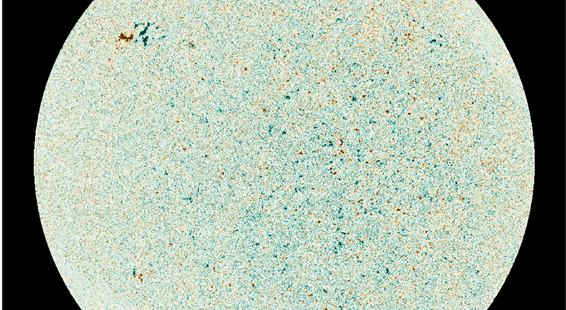First autonomous magnetic field map of the Sun, obtained by an instrument co-developed by IEEC for Solar Orbiter

The Solar Orbiter has taken images of the Sun’s surface from the closest distance ever reached
The SO/PHI instrument, co-developed by IEEC researchers at the Institute of Cosmos Sciences of Universitat de Barcelona (ICCUB), has obtained the first magnetic field map of the star's surface from space and without human intervention
The Solar Orbiter mission, developed by the European Space Agency (ESA) with the participation of NASA, took off into orbit around the Sun on 9 February 2020. Few months later, it has already achieved its first scientific results, which were presented on 16 July in a press conference.
The mission was designed to observe the Sun from an unprecedented perspective and to study solar physics and the influence of the Sun on the interplanetary environment. The Solar Orbiter spacecraft has approached the closest point to the Sun ever reached: 77 million kilometers. During the mission it will reach even closer, at 42 million kilometers away.
Researchers from the Institute of Space Studies of Catalonia (IEEC) at the Institute of Cosmos Sciences of the Universitat de Barcelona (ICCUB) have worked on one of the instruments aboard Solar Orbiter, the Polarimetric and Helioseismic Imager (SO/PHI). The SO/PHI instrument makes high-resolution measurements of the magnetic field lines on the surface of the Sun and has allowed us to obtain the first solar magnetic field map obtained from space and without human intervention.

Caption: Solar magnetic field map obtained with the SO/PHI instrument. SOLAR ORBITER/ PHI/ ESA/ NASA
The SO/PHI is designed to monitor active regions on the Sun, areas with especially strong magnetic fields, which can give birth to solar flares. The ICCUB has been responsible for developing and implementing an image stabilization system (ISS) that has made it possible to compensate for the movements of the probe in order to obtain images of the required quality. "Solar Orbiter is the most complete solar mission from an instrumental point of view," explains Josep M. Gómez Cama, a researcher from IEEC at ICCUB and member of the Department of Electronic and Biomedical Engineering at the Universitat de Barcelona. Specifically, the probe incorporates ten instruments that weigh a total of 209 kg. Four of the instruments, which allow the detection of solar wind (plasma and magnetic field), radiation and emitted particles, work in situ, while the other six do so remotely and allow images to be obtained at different wavelengths and spectroscopy of the solar photosphere and corona.
The SO/PHI has been built by an international consortium (45% Germany, 42% Spain, 10% France and the rest, other countries). The Spanish part has been coordinated by the Institute of Astrophysics of Andalusia (IAA-CSIC), with the participation of ICCUB, the National Institute of Aerospace Technology (INTA), the Polytechnic University of Madrid, the University of Valencia and the Institute of Astrophysics of the Canary Islands.
Step forward for space meteorology
In addition, researchers from the Heliospheric Physics and Space Meteorology Group (HPSWG) at ICCUB have provided scientific support to the Energy Particle Detector (EPD) team, another instrument aboard the Solar Orbiter. THe HPSWG members, experts in modeling and data analysis, developed models to predict the particle radiation environment that Solar Orbiter is facing, and developed tools to facilitate the analysis of the particle measurements it collects. According to Àngels Aran, a researcher of IEEC at ICCUB in the HPSWG group, "the results obtained by Solar Orbiter will allow us to understand the physics that connects the star with the interplanetary environment and thus adjust current models of space meteorology."
The mission is now in an initial cruising phase, which will run until November 2021. The Solar Orbiter has revolved around the Sun in an orbit with a minimum distance less than that of Mercury and outside the ecliptic, which provides a unique perspective that allows us to observe the Sun's poles. The first quality view of their magnetic field will be obtained as the Solar Orbiter elevates its orbital plane to access high latitudes. In addition, the instruments will take local and remote measurements, which will provide the first complete view of both solar physics and the heliosphere. Understanding the coupling of the Sun and the heliosphere is essential to understanding how our solar system works.
First results by Solar Orbiter (ESA)
Links
More information
The Institute of Space Studies of Catalonia (IEEC — Institut d’Estudis Espacials de Catalunya) promotes and coordinates space research and technology development in Catalonia for the benefit of society. IEEC fosters collaborations both locally and worldwide and is an efficient agent of knowledge, innovation and technology transfer. As a result of over 20 years of high-quality research, done in collaboration with major international organisations, IEEC ranks among the best international research centers, focusing on areas such as: astrophysics, cosmology, planetary science, and Earth Observation. IEEC’s engineering division develops instrumentation for ground- and space-based projects, and has extensive experience in working with private or public organisations from the aerospace and other innovation sectors.
IEEC is a private non-profit foundation, governed by a Board of Trustees composed of Generalitat de Catalunya and four other institutions that each have a research unit, which together constitute the core of IEEC R&D activity: the University of Barcelona (UB) with the research unit ICCUB — Institute of Cosmos Sciences; the Autonomous University of Barcelona (UAB) with the research unit CERES — Center of Space Studies and Research; the Polytechnic University of Catalonia (UPC) with the research unit CTE — Research Group in Space Sciences and Technologies; the Spanish Research Council (CSIC) with the research unit ICE — Institute of Space Sciences. IEEC is integrated in the CERCA network (Centres de Recerca de Catalunya).
Contacts
IEEC Communication Office
Barcelona, Spain
Ana Montaner Pizà
E-mail: comunicacio@ieec.cat
Institute of Cosmos Sciences (ICCUB)
Barcelona, Spain
Josep M. Gómez Cama
E-mail: jm.gomez@ub.edu
